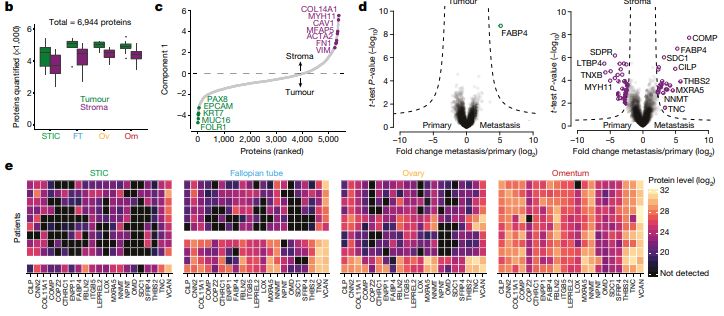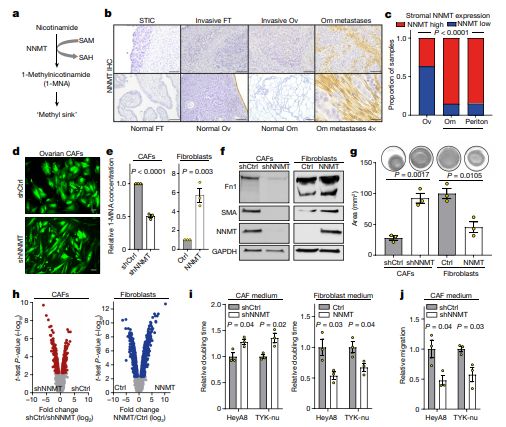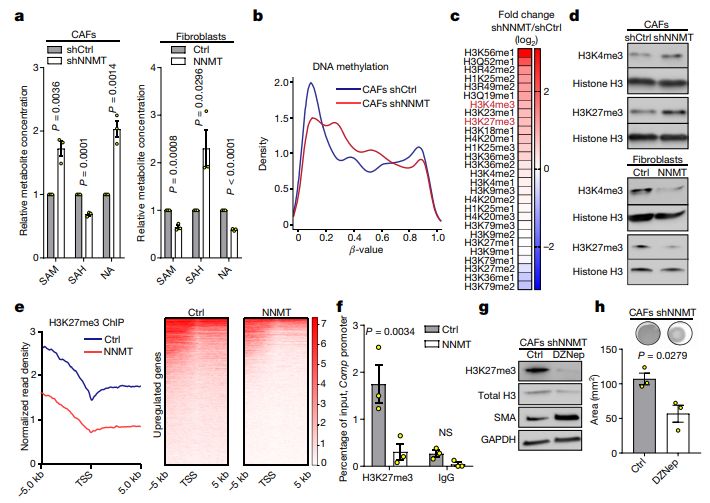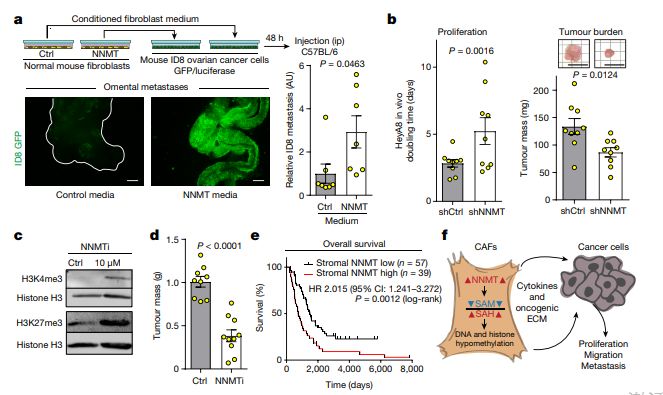Tumor metastasis has always been a major problem that plagues cancer treatment. On May 2nd, the Ernst Lengyel research team from the University of Chicago published a study entitled " Proteomics reveals NNMT as a master metabolic regulator of cancer-associated fibroblasts " in the top journal Nature.
Using proteomic analysis , the researchers found a nucleus NNMT (nicotinamide N-methyltransferase), a key target protein that is expected to be an intervention target for the inhibition of ovarian cancer cell metastasis.

Proteomics reveals NNMT as a master metabolic regulator of cancer-associated fibroblasts
Nature IF= 41.577
Original link:
Https://
Research Background:
High-grade serous ovarian cancer (HGSC) has always had a poor prognosis, and early abdominal metastasis is the primary cause of poor prognosis.
In the past, several omics articles have described the protein expression characteristics of ovarian cancer. However, there is no article to further distinguish the difference between cancer cells and the surrounding matrix of cancer cells. The HGSC tissue has a high proportion of matrix, given that the matrix supports the tumor and that the matrix co-evolves with the epithelium during tumor development and metastasis. Therefore, systematic analysis of the tumor and its surrounding matrix can help us understand the mechanism of ovarian cancer metastasis.
research method:
Using laser capture microdissection + high sensitivity proteomics , 107 tumor tissues and tumor surrounding stroma were extracted from paraffin-embedded tissues of 11 HGSC patients, followed by proteomic analysis.

research material:
107 tumor tissues, tumor surrounding stroma; mouse model of HGSC metastasis
Research result:
1. Proteomic analysis: revealing the characteristics of HGSC metastasis and selecting factors that potentially regulate tumor metastasis
A total of 6944 proteins were identified by proteomic analysis. In the tumor tissues, several known markers of HGSC (PAX8, MSLN, MUC16, EPCAM) were identified, while in the matrix part, some markers of fibroblast activation were identified (collagens, vimentin, versican, tenascins). , myosin). To further compare the differences between primary and metastatic tumors, the researchers found many differential proteins, and many of them have been reported to be involved in retinal metastasis. In the analysis of matrix components, the authors identified a total of 62 protein-significant differential proteins. Through differential screening and literature research, the researchers finally selected a protein involved in epigenetic regulation, NNMT, for further study.

Figure 1. Proteomics of tumor tissue and peripheral stroma reveals the characteristics of HGSC metastasis
2. Verify and explore NNMT function: NNMT is highly expressed in tumor metastatic matrix and regulates CAF phenotype
NNMT is a factor involved in epigenetic regulation that regulates gene expression by affecting histone methylation. To verify whether NNMT is an "accomplice" to tumor metastasis, the researchers first used immunohistochemistry to verify that NNMT is indeed highly expressed in the tumor stroma of the retina.
Subsequently, the researchers further investigated the role of NNMT in regulating CAF phenotype to determine its function in tumor metastasis. Cancer-associated fibroblasts (CAFs) are fibroblasts produced in vivo that can be hijacked and used to maintain their growth and metastasis. The study found that knocking down NNMT in CAF would make cell morphology more normal cells. In addition, NNMT not only regulates the contractility of collagen, but also regulates the expression of thousands of genes, including some cancer-promoting factors.

Figure 2. High expression of NNMT in tumor metastatic matrices and regulation of CAF phenotype
3. Research on the regulation mechanism of NNMT : NNMT drives CAF phenotype by regulating methylation of DNA and histones
Subsequently, combined with the previously reported NNMT function and in-depth mechanism, the researchers found that NNMT regulates the phenotype of CAF by reducing the methylation level of DNA, RNA or histones and changing the gene expression level.

4. Mouse tumor metastasis model and clinical data validation: NNMT of matrix is ​​involved in tumor metastasis and is associated with poor prognosis
Finally, the researchers used a mouse model to validate the findings. After ovarian cancer cells pretreated with medium overexpressing NNMT cells, ovarian cancer cells were inoculated into a mouse model and found to have significantly higher retinal metastasis than the control group. Conversely, if NNMT knockdown cells are co-injected with HGSC cells into mice, tumor cell proliferation and tumor size are significantly reduced.
In addition, analysis of clinical data validated this conclusion. The study found that patients with high NNMT expression in the stroma had shorter survival and worse prognosis, but there was no significant difference in patients with high NNMT expression in tumor tissues.

Figure 4 Matrix NNMT is involved in tumor metastasis and is associated with poor prognosis
5 Conclusion
NNMT is a key regulatory molecule that maintains the phenotype of CAF cells, and plays an important role in the development and metastasis of ovarian cancer.
Xiaobian summary:
This article is another masterpiece of using proteome to study tumorigenesis, development, and metastasis. In proteomics, Zhongke New Life has a rich, comprehensive proteomics product and one-stop service: from conventional proteomics, full-scan proteome (DIA), to PRM validation, plus transcription + protein, protein + Metabolic joint analysis , we are committed to providing you with a complete solution.
Palm Recognition Time Attendance
Palm Recognition Time Attendance,Biometric Time Attendance System,Biometric Face Recognirion Software,Palm Recognition Temperature Face Time Attendance
Shenzhen Bio Technology Co., Ltd , https://www.huifantech.com